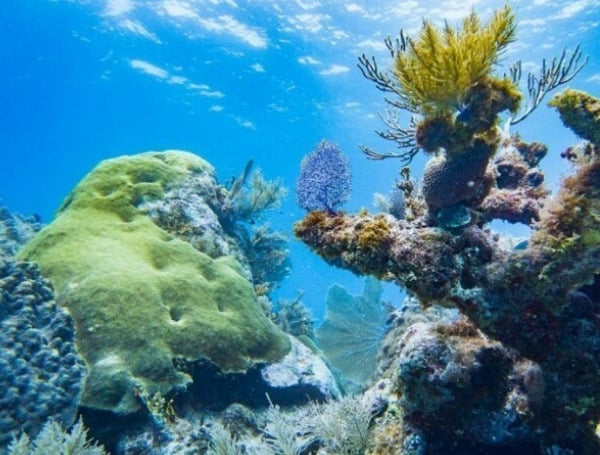Sure, you’ve heard of Australia’s Great Barrier Reef, but have you heard of Florida’s coral reef?
It’s big, it’s beautiful, it’s one of the many things that makes Florida special. But despite its grandeur and vital importance, many don’t realize that just off Florida’s coast is the only living barrier reef in the continental U.S.
This natural wonder stretches more than 350 miles from the Dry Tortugas to Martin County. To put that in perspective, that’s like driving from Miami to Jacksonville.
Why is this important? Because Florida’s coral reef not only acts as a buffer to the coastline when storms hit, it is the crown jewel of Florida’s coastal resources, providing shelter, food and breeding sites for many of your favorite marine species. Black grouper anyone?
Each year, Florida’s coral reef supports over 71,000 full- and part-time jobs and generates over $6.3 billion in combined local sales and income associated with snorkeling, scuba diving, fishing, beach activities and more.
But in case you’ve missed it in the news, Florida’s coral reef has been suffering from a hard-to-beat illness.
Stony coral tissue loss disease has been ravaging Florida’s coral reef for over 7 years, killing millions of coral colonies.
Nearly half of Florida’s 45 stony coral species are impacted by this disease, including major reef-building corals like boulder and brain corals.
While coral diseases are common, similar to colds in humans, this disease event is unique due to its large geographic range, long duration, rapid spread through the entire reef, high rates of mortality and the large number of species affected.
Florida Fish and Wildlife Conservation Commission (FWC) biologist John Hunt, who has been studying and diving Florida’s coral reef for 40 years, recalls the beauty that once was, and the devastation that he sees today.
“When I arrived in the Florida Keys in 1981 from North Carolina, Florida’s offshore coral reefs were filled with large branching corals so big that you’d sometimes have to go around them when snorkeling. They were very colorful, vibrant and filled with fish and corals,” said Hunt. “Today, 40 years later, those vertical coral structures are gone, and the vibrant colors of the reef have become dull. I swim over them, and that level of excitement and anticipation I used to feel is just a little bit less.”
You can start by visiting MyFWC.com/CoralDisease, learning as much as you can about Florida’s Coral Reef and the disease and by finding ways to get involved, such as joining Florida’s Coral Crew.
Here are a few other things you also can do to help:Avoid touching corals while diving.
- Avoid touching corals while diving.
- Don’t anchor near corals and be aware of shallow reef areas.
- Clean diving gear between dives in different locations.
- Report any observations of coral disease, or other marine incidents to SEAFAN: www.SEAFAN.net.
- Use environmentally friendly sunscreens made from zinc or titanium dioxide (or that do not contain oxybenzone or octinoxate).
- Practice Florida-Friendly Landscaping™ and avoid over-fertilizing or applying fertilizer before heavy rains.
- Secure your trash on your boat and bring reusable water bottles.
- Support coral research through the Fish & Wildlife Foundation of Florida. Learn more at WildlifeFlorida.org.
“My hope is the restoration activities that we are all embarking on will restore that structure and vibrancy,” said Hunt.
Saving Florida’s corals isn’t just about stopping the disease, it’s about creating a healthy coral reef that can better withstand the disease and other impacting factors. Because healthy habitats equals more fish and, let’s face it, we all want more fish.
Did you know?
Coral reefs occupy less than 1% of the world’s oceans, but it is estimated that approximately 25 percent of marine fish species inhabit coral reefs during some part of their lives.
- Florida Gov. DeSantis Expresses Concern About Biden Admin Cutting Supply Of Effective Antibody Treatments
- A Message From Florida’s New Public Health Chief: The State Will ‘Completely Reject Fear As A Way Of Making Policies In Public Health’
- Florida Man Steals Pickup Truck, Crashes, Pretends To Grill On Strangers Porch
- “Gut Him” Florida Woman Pulls Knife On Man After Dispute Over Her Passing Gas At Dollar General
- Florida Man And Woman, In Colorful Simpsons Shirts, Arrested On Multiple Drug Charges
- “Snickers Satisfies” Florida Man Arrested After Armed Robbery Of A Snickers Bar At Wawa
- Oops: Another Florida Pro-Mask Mandate Lib Caught Partying It Up Without A Mask
Support journalism by clicking here to our gofundme or sign up for our free newsletter by clicking here
Android Users, Click Here To Download The Free Press App And Never Miss A Story. It’s Free And Coming To Apple Users Soon.


